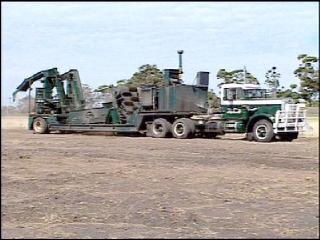|
|||||||||||||||||||
|
|||||||||||||||||||
|
Green Lead MCA speech Notes for the PowerPoint
presentation |
|||||||||||||||||||
|
About Us Visitor
Number |
|||||||||||||||||||
|
"GREEN LEAD" – OXYMORON OR FUTURE VISION? Elizabeth O’Briena,
Cornelia Dostb, Bei Quc a Manager, b,c Interns, Contents E-EQUIPMENT E-equipment is another main lead use in the world. In 2003 almost every second Australian household was in possession of a computer and more than 36% of Australian households had Internet access at home. The increase in the use of new technology is enormous and Australia is one of the top ten countries using IT (Ha, 2003). But with new and more electronic equipment at home and at work, problems of waste management arise. Experts are expecting a major increase in the following years in the volume of computer and TV monitors that will not be used anymore. One main reason for this is the replacement of cathode-ray tube (CRT) monitors by liquid crystal display (LCD) screens. Consequently, this could mean a massive dumping of CRT monitors (BAN and SVTC, 2002). Bearing in mind that the cathode ray tube in a standard monitor contains an average of 1.7 kg of lead (CEIA, 2001)! A whole computer contains approximately 6.3% lead. Lead is used in metal joining, radiation shield/CRT and Printed Wiring Boards (PWB). The life span of a computer is only two years on average. Experts estimate that between the years 1997 and 2007, more than 500 million computers will become obsolete in the United States. 500 million computers contain 1.58 Billion pounds of lead that has to be dealt with (BAN and SVTC, 2002). As noted by UNEP (2005): "Every year, 20 to 50 million tons of electrical and electronic equipment waste ("e-waste") are generated world-wide, which could bring serious risks to human health and the environment." It has become appallingly obvious that our technology has exceeded our humanity as Albert Einstein fittingly stated some years ago. What happens to all the used material and products which are not needed anymore? Although we like to think that e-waste could be recycled properly it still goes to recycle markets in the developing world or is dumped in state owned landfills. "ZERO HARM" Damage exported When one recycles a hazard, one is left with a hazard – and are we not all trying to eliminate hazards?’ (Puckett, 2003) Each year Australians discard about 8,000 tonnes of used batteries. According to Canon Australia the country could reduce or eliminate its export of used batteries with the help of a domestic battery recycling facility (Canon, 2005). According to Klaus Toepfer of the United Nations Environment Programme, "The recycling of lead-acid batteries is one of the greatest potential sources of risk, especially for exposed workers in the informal sector in many developing countries. The safe recycling of these batteries requires strict environmental and occupational standards that can only be ensured by specialized firms, of which only a few are found in developing countries" (UNEP 2002). Moreover, operating costs of recycling facilities (for instance in terms of labour, health and environmental costs) are far lower, which makes the export of scrap materials more competitive and economically efficient (Cobbing and Divecha, 1994). In addition, large numbers of e-equipment are exported to many developing countries. In China alone, for example, 4 million PCs are discarded per year (UNEP, 2005a). Lead contains toxic materials that heavily pollute the environment. Electronic products contain toxic chemicals that find their way into the ground and end up in the atmoshere later via evaporation. During the smelting and refining process particulate material (including lead and other heavy metals) and acidic materials (sulfur dioxide) gets into the atmosphere. Also the discharge of contaminated industrial waste and the leakage of acidic electrolyte during battery storage are of high concern (Hay and Noonan, 2001). Because of that, internal costs, and environmental controls have arisen in the industrialized world. Some smelters even had to close. Nonetheless, there are many smelters in developing countries which continue to pollute the environment and expose the workers, and through them also their children, to significant health risks. One of the main recycling ports in China is the town of Guiyu where it is common to see open burning of plastics and wires and smelting of circuit boards to reclaim metals. The workers, some of whom are children or have children who must come to work with them (see Figure 4),
generally work without facemasks or protective clothing. Because of a lack of technical knowledge on how to recycle electronic goods safely, people are exposed to hazardous metals which harm their health. Though the workers are exposed to toxic dusts and fumes they are still willing to do this kind of job to earn money for their daily life (about 3 Yuan per hour which is nearly A$0.50 cents) (Chinese Environment Law, 2004). The area’s soil and water is so contaminated that Guiyu's inhabitants have to go 30 km away from the town for proper drinking water. A river water sample from the Lianjiang river near a Chinese "recycling village" revealed lead levels that were 2 400 times higher than World Health Organization Drinking Water Guidelines. "Sediment samples there showed lead levels 212 times higher than what would be treated as hazardous waste had it been dredged from the Rhine River bottom in the Netherlands." (BAN and SVTC, 2002) Even part of a computer used by the New York Stock Exchange was discovered on the Chinese dumping ground as Figure 5 shows.
What we call "recycling" today is the removal of hazardous material from the first stage and their reuse for further production. Accordingly, these products eventually have to be disposed. ‘We, as a society, should always be aware that we have a responsibility towards future generations. The main goal of any "green lead" program should be minimizing use of lead in products, maximizing recycling, reduction of mining and provision of information and assistance for the safe management of all the lead already in the environment for all eternity. Contents |
|||||||||||||||||||
|
About
Us |
bell
system lead poisoning |
Contact Us
| Council
LEAD Project | egroups | Library
- Fact Sheets | Home
Page | Media Releases |
|||||||||||||||||||
|
Last Updated 21 August 2014
|
|||||||||||||||||||





